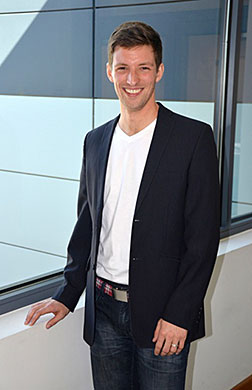- Number 395 |
- August 19, 2013
Computing quarks on a chessboard

Chris Monahan, a postdoctoral research
associate at The College of William & Mary,
is the recipient of the 2013 Jefferson Science
Associates Postdoctoral Research Grant at
Jefferson Lab. Monahan's research will use a
new approach for calculating how the
smallest bits of matter come together to build
the ubiquitous proton.
Scientists have long puzzled over how the smallest bits of matter add up to form the world around us. Now, Chris Monahan of DOE's Jefferson Lab is using the power of a video gaming system to attempt a new method of exploring those bits.
More specifically, Monahan’s project is to calculate how the smallest bits of matter, quarks and gluons, come together to build the ubiquitous proton.
"This project is aimed at developing a new way of comparing numerical data from a computer to experimental data. There are a number of ways of doing this, but none of them are ideal. This won't be ideal, but it takes advantage of some new developments," Monahan explains.
The method uses lattice QCD, an approach that harnesses the power of supercomputers to solve the theory that describes how quarks and gluons build protons, neutrons and other particles in the heart of matter. Lattice QCD helps simplify the problem by breaking up space and time into a grid system that a computer can use to calculate numerically the behavior of quarks and gluons.
"I like to picture it like a chessboard. You can imagine that the quarks could really live anywhere on the chessboard. But a computer can't deal with so many possibilities. So instead, you say they can only appear on the black squares. That way, you've only got a finite number of possibilities to deal with," he says.
To increase the accuracy of the computations, the scientists need to make the squares smaller. However, the problem with this method is that the smaller you make the squares, the longer it takes for the computer to run the calculation. Monahan's method may get around that issue. He plans to use the power of a graphics processing unit, the same type of processor that powers gaming systems, to compute the problem differently.
"Instead of making the black squares smaller, you could make the quarks bigger. And then the black squares look smaller to the quarks, comparatively," he explains.
If the new approach works, Monahan says the method could require less computing power to perform these difficult calculations, saving time and money while also benefiting physicists who compare such calculations to the results they get from experiments probing quarks and gluons.
Monahan is conducting the study with fund he received as winner of the 2013 Jefferson Science Associates Postdoctoral Research Grant at DOE's Jefferson Lab. The grant provides $11,000 for his research. He plans to use about a third of the grant to assemble a computer for testing the new method, another third to fund a graduate student to assist with the programming and the last third to attend an international conference of lattice QCD physicists in hopes of presenting his first results.
"Chris Monahan's lattice QCD work is particularly promising, and we are looking forward to his results and potential positive impact on Jefferson Lab research," says Hugh Montgomery, JSA president and Jefferson Lab director.
Monahan completed his undergraduate degree in physics (M.Phys.) at the University of Edinburgh and his Ph.D. at the University of Cambridge. He is currently a postdoctoral research associate at The College of William & Mary.
The JSA Postdoctoral Research Grant has been awarded annually since 2008 by the Users Group Board of Directors, the governing body of the group that represents scientists who use Jefferson Lab facilities to conduct nuclear physics research. In making the award, the board judges each applicant on his or her record of accomplishment in physics, proposed use of the research grant and the likelihood of further accomplishments in Jefferson Lab research fields. The research grant is one of the funded projects of the JSA Initiatives Fund program, provided by Jefferson Science Associates to support programs, initiatives, and activities that further the scientific outreach, and promote the science, education and technology missions of Jefferson Lab and benefit the lab’s user community.Submitted by DOE’s Thomas Jefferson Accelerator Facility
